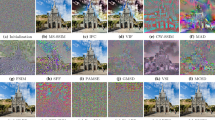Abstract
Constructing objective assessment model on visual quality is challenging, since it associates closely with many factors in human visual perception, as well as both source coding and transmission. In this paper, a no reference hybrid model for video quality assessment is proposed by employing Partial Least Squares Regression (PLSR). The hybrid model combines both bitstream-based features and network-based features, taking into video quality dependence on visual content and network conditions account. We have conducted subjective tests to validate its quality assessment accuracy. Simulation results in Network Simulator version 2 (NS-2) verify the performance advantage of the hybrid model for SD (standard definition) and HD (high definition) video sequences. Proposed model could be used as a quality monitoring tool for assessing the real-time video quality during wireless transmission. Simulation results show that the devised model can improve the quality prediction against a full-reference metric, and achieves a high correlation (0.955) between quality prediction and the actual perceived quality judged by subjective assessment.




Similar content being viewed by others
References
Abdelkefi, A., Yuming Jiang May (2011) A Structural Analysis of Network Delay. IEEE Communication Networks and Services Research Conference (CNSR), 2011 Ninth Annual, Ottawa Canada pp.41–48
Angrisani L, Capriglione D, Ferrigno L, Miele G (2012) A methodological approach for estimating protocol analyzer instrumental measurement uncertainty in packet jitter evaluation. Instrum and Meas, IEEE Trans 61(5):1405–1416
Bro R. Jan.(1996) Multiway Calidration. Multilinear PLS. Journal of chemometrics. vol.10, Is.1, pp.47–61
Fan Z, Weisi L, Zhibo C, King NN (2013) Additive Log-logistic model for networked video quality assessment. IEEE Trans On Image Process 22(4):1536–1547
Farias M, Carvalho M, Kussaba H, Noronha B (2011) A hybrid metric for digital video quality assessment. IEEE International Symposium on Broadband Multimedia Systems and Broadcasting (BMSB). Nuremberg, Germany.pp.1–6. Jun
Five datasets of high definition television :http://www.its.bldrdoc.gov/vqeg/downloads.aspx
Ke C-H, Lin C-H, Shieh C-K, Hwang W-S June (2006) A novel realistic simulation tool for video transmission over wireless network. IEEE International Conference on Sensor Networks, Ubiquitous and Trustworthy Computing, Taiwan. pp.5–7
Keimel, C., Habigt, J., Klimpke, M., Diepold, K Sept. (2011) Design of no-reference video quality metrics with multiway partial least squares regression. Quality of Multimedia Experience (QoMEX) 2011 Third International Workshop on pp.49–54, 7–9
Khan E, Ghanbari M (2007) Wavelet-based video coding with early-predicted zerotrees. Image Process, IET 1(1):95–102
Lin C-H et al. (2006) The Packet Loss Effect on MPEG Video Transmission in Wireless Networks. Advanced Information Networking and Applications - AINA pp. 565–572
Liu T, Wang Y, Boyce JM, Yang H, Wu Z (2009) A novel video quality metric for low bit-rate video considering both coding and packet-loss artifacts. IEEE J of Sel Top in Signal Process 3(2):280–293
Mu M, Mauthe A, Garcia F (2010) A Discrete Perceptual Impact Evaluation Quality Assessment Framenwork For IPTV Services.
Panayides A, Pattichis MS, Pattichis CS (2011) Atherosclerotic plaque ultrasound video encoding, wireless transmission, and quality assessment using H.264. Inf Technol in Biomed, IEEE Trans 15(3):387–397
Park I, Na T and Kim M Jan. (2011) A noble method on noreference video quality assessment using block modes and quantization parameters of H.264/AVC. Image Quality and System Performance Proc. SPIE California USA.pp.7867-7877
Raake A, et al. (2008) TV-MODEL: Parameter-based prediction of IPTV Quality. Proc. of ICASSP08, pp. 1149–1152
Slanina M, Ricny V, and Forchheimer R Jun (2007) A novel metric for H.264/AVC no-reference quality assessment. in EURASIP Conference on Speech and Image Processing, Multimedia Communications and Services. Maribor Slovenia pp.114–117
Staelens N, Sedano I, Barkowsky M, Janowski L, Brunnstrom K, Le Callet P Sep.(2011) Standardized tool chain and model development for video quality assessment-The mission of the joint effort group in VQEG. in Quality of Multimedia Experience(QoMEX), Mechelen, Belgium. pp.61–66
Stockhammer T, Hannuksela MM (2005) H.264/AVC video for wireless transmission. IEEE Wirel Commun 12(4):6–13
Sugimoto O, Naito S, Sakazawa S, and Koike A Nov. (2009) Objective perceptual video quality measurement method based on hybrid no reference framework. 16th IEEE International Conference on Image Processing (ICIP), Cairo, Egypt.pp. 2237–2240
Wang Z, Bovik A, Sheikh H, Simoncelli E (2004) Image quality assessment: from error visibility to structural similarity. IEEE Trans Image Process 13(4):600–612
Yamada T, Miyamoto Y, and Serizawa M Nov. (2007) No-reference video quality estimation based on error-concealment effectiveness. in Proc. IEEE Packet Video, Lausanne, Switzerland
Yamagishi K and Hayashi T (2008) Parametric packet-layer model for monitoring video quality of IPTV services
Yamagishi K, Kawano T, Hayashi T (2009) Hybrid video-quality-estimation model for IPTV services. IEEE Global Telecommunications Conference Honolulu pp.1–5
Yamagishi, K.; Kawano, T.; Hayashi, T. Nov. (2009) Hybrid Video-Quality-Estimation Model for IPTV Services. IEEE Global Telecommunications Conference, GLOBECOM 2009, Honolulu, USA. pp.1–5
You F et al. (2009) Packet Loss Pattern and Parametric Video Quality Model for IPTV. in Proceedings of the 2009 Eigth IEEE/ACIS International Conference on Computer and Information Science pp. 824–828.
Acknowledgments
This work was partially supported by the National Natural Science Foundation of China (No: 60963011, 61162009), and the Jiangxi Natural Science Foundation of China (No: 2009GZS0022).
Author information
Authors and Affiliations
Corresponding author
Rights and permissions
About this article
Cite this article
Wang, Z., Wang, W., Wan, Z. et al. No-reference hybrid video quality assessment based on partial least squares regression. Multimed Tools Appl 74, 10277–10290 (2015). https://doi.org/10.1007/s11042-014-2166-0
Received:
Revised:
Accepted:
Published:
Issue Date:
DOI: https://doi.org/10.1007/s11042-014-2166-0




